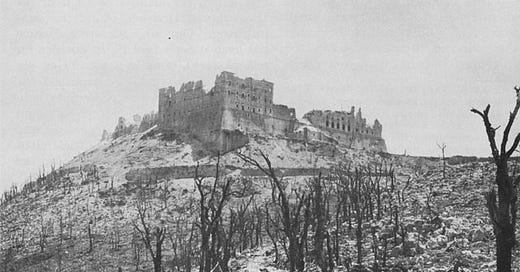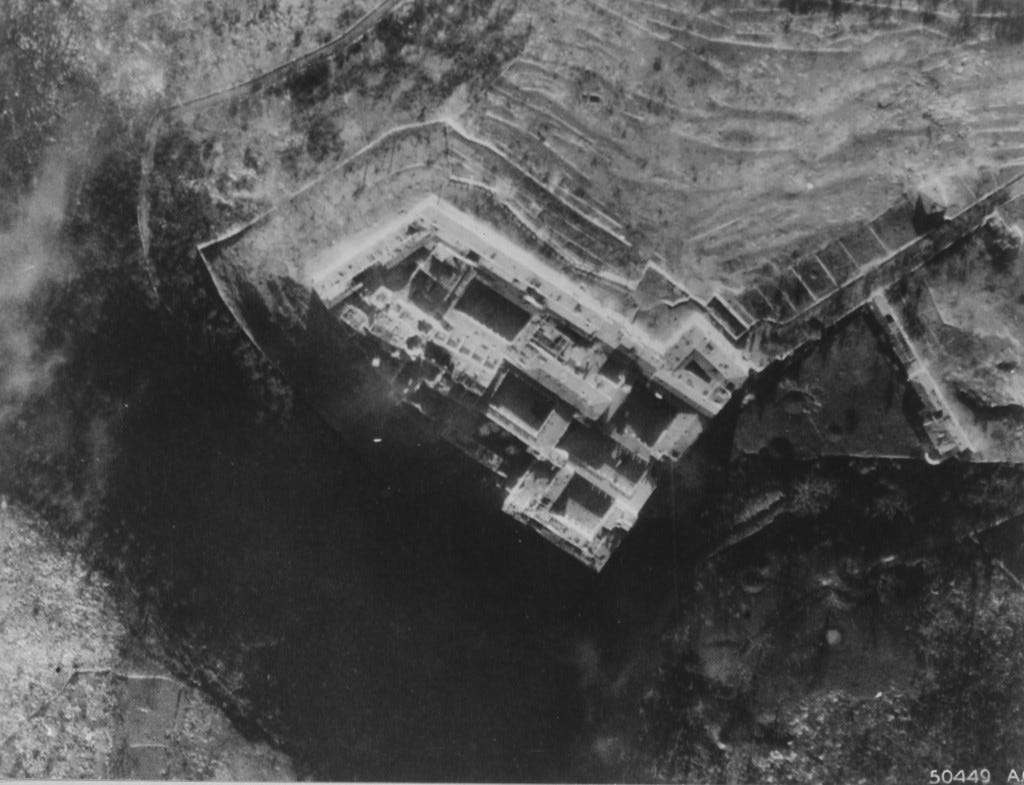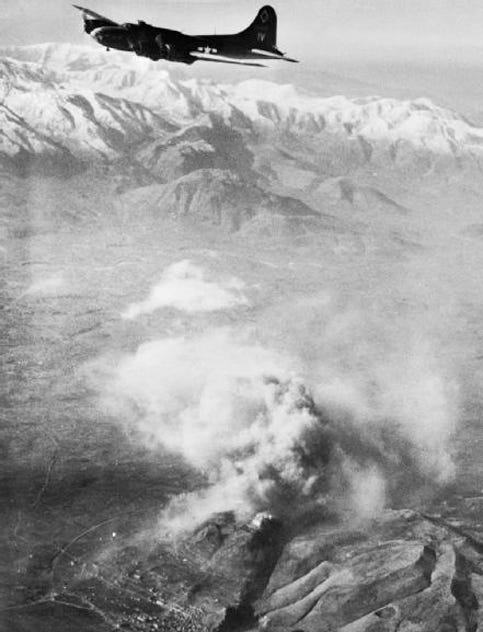Bombing Monte Cassino
From the time Allied troops moved into mainland Italy in mid-1943, debates about how to handle the country's religious landmarks vexed top military and political officials in the U.S. and U.K.
While winning the war was their unquestioned priority, they were cognizant of public opinion when it came to unnecessary destruction of culturally significant sites, and field commanders had been instructed to avoid damaging them whenever possible. When U.S. bombers first hit Rome in July 1943, for instance, aircrews were given detailed maps depicting key sites and ordered to keep their munitions away from them.
Even as the ground war in Italy deteriorated into a muddy stalemate over the winter of 1943-44, military leaders doubled down on those directives. On Dec. 29, 1943, Gen. Dwight D. Eisenhower wrote in a memo to his commanders that the Allies were "bound to respect those monuments so far as war allows." He continued:
If we have to choose between destroying a famous building and sacrificing our own men, then our men’s lives count infinitely more and the buildings must go. But the choice is not always so clear-cut as that. In many cases the monument can be spared without any detriment to operational needs.
Nothing can stand against the argument of military necessity. That is an accepted principle. But the phrase ‘military necessity’ is sometimes used where it would be more truthful to speak of military convenience or even personal convenience. I do not want it to cloak slackness or indifference.
However noble the motives, this understandably wasn't a particularly popular stance among those in the field.
That included some correspondents on the scene, most notably C.L. Sulzberger of The New York Times among the U.S. press contingent. As the nephew of the newspaper's publisher, Arthur Hays Sulzberger, Cy had plenty of influence, and he would become perhaps the most high-profile press critic of this policy -- particularly when it came to the centuries-old Benedictine monastery atop Monte Cassino.
The fortress-like abbey offered a commanding view for miles around, and it seemed only natural to the Allied troops who had tried unsuccessfully to take the hill that the German defenders were using the monastery itself as a base. In a story published Jan. 29 about Lt. Gen. Mark Clark's "strict instructions" to carefully avoid attacks on Catholic church property, Sulzberger seemed to argue that the abbey was a legitimate target.
"There seems little doubt that they are employing it as an artillery observation post, for which its position, dominating the valley, is wonderful," Sulzberger wrote.
Though there was no firm evidence that the Germans were using the abbey for military purposes, Sulzberger would hit on this theme repeatedly, and with increasing certitude, in the coming days. In the Jan. 31 Times, he mentioned a reconnaissance flight that had surveyed the entire region two days earlier: "These fliers are convinced that the enemy is employing the monastery as an artillery observation post, knowing that the Allies' regard for clerical monuments forces our batteries to abstain from shelling."
By the Feb. 4 edition, Sulzberger had dropped any conditional pretense and stated flatly: "The monastery is used as a German observation post."
The correspondent's confidence in that assessment undoubtedly was a reflection of military officials on the ground around him, though there was hardly a consensus in Allied ranks at that point. The senior commander, Lt. Gen. Sir Bernard Freyberg, was the most vocal advocate of bombing or shelling the abbey. According to the official U.S. Army history, Freyberg called Clark's headquarters on the evening of Feb. 12 and spoke to the Fifth Army chief of staff, Maj. Gen. Alfred Gruenther, requesting a bombing raid on the abbey.
Gruenther sent the request up the chain of command and found that Clark and others did not believe destroying the abbey was a "military necessity." But they were eventually overruled by Clark's superior, 15th Army Group commander Gen. Sir Harold Alexander, who authorized the bombing based on Freyberg's argument -- a position shared by many if not most of the men around him.
Reuters correspondent Doon Campbell quoted Pvt. John Mooney of Airdrie, Scotland: "I am a Roman Catholic and from a religious point of view I do not want it to happen, but if it is going to impede the progress of the war, then smash it, because we want the war over before everything else."
On Feb. 14, troops of the 4th Indian Division, who had been nearest the hilltop, fell back from their positions. That evening, Allied planes dropped leaflets on the Cassino area. They read: "Italian friends: Until this day we have done everything to avoid bombing the abbey. But the Germans have taken advantage. Now that the battle has come close to your sacred walls we shall, despite our wish, have to direct our arms against the monastery. Abandon it at once. Put yourselves in a safe place. Our warning is urgent."
The occupants of the abbey -- a handful of monks and hundreds of civilians -- were informed of the leaflets and began to make evacuation plans. But the bombers appeared the next morning, beginning around 9:45, before any major exodus had begun.
Nearly 250 U.S. Army Air Forces planes, mostly B-17s, would eventually drop more than 1,100 tons of explosives on the hilltop, their ordnance supplemented by artillery fire hitting the abbey between bombing waves. By afternoon, the abbey was a smoking pile of rubble.
C.L. Sulzberger's story on the front page of the Feb. 16 New York Times began this way:
The massive Abbey of Mount Cassino, built on the site where St. Benedict founded his holy order of monks, suffered today the worst aerial and artillery onslaught ever directed against a single building. It crumbled slowly into ruins beneath vast clouds of smoke as the German soldiers who had violated all civilized codes by employing the sanctuary for military purposes met their day of wrath.
In the weeks leading up to the bombing, several British newspapers also had advocated for an attack on the abbey, and their accounts also perpetuated the notion that the building was being used as a fortress -- an argument bolstered by official Allied communiques on Feb. 15 that cited some 300 Germans supposedly seen fleeing the position during the raids.
A correspondent from London's Daily Herald sought to alleviate any questions with his front-page account:
Doubtless there will be arguments for many years to come about the deed that was done between 9 and 2 p.m., but in the minds of the men on our side of the Rapido valley one fact stood out.
The Germans had used this monastery as a machine-gun nest, hideout, and observation post from which to direct fire to kill Allied soldiers.
We had warned them we were going to bomb it. We had fired leaflets at it, telling Italians who might be sheltered there to get out. And to-day, less than 24 hours after our warning, we fulfilled our promise.
While firm in upholding the military justification for the bombing, the Daily Herald correspondent's dispatch differed from others in one significant way. The end of the story struck a sorrowful tone, noting that among the assembled troops, "there were no cheers. Our men were silent as they watched a fine old building destroyed because of the grim demands of war."
Other observers told quite a different story, with American correspondents comparing soldiers' reactions to those that might be seen at a sporting event. Wrote William Strand of the Chicago Tribune:
The sentiment of the soldiers watching the attack was not hard to gauge. They have fought and seen their comrades killed under the shadow of the abbey for many days. The sight of the place being attacked brought broad grins to their faces.
"It should have been done a long time ago," exclaimed Cpl. William Hauberg of Hoosick Falls, N.Y. "The Jerries have been using it for observation at a cost of lots of our men."
Strand's account later continued:
Binoculars were focused amid jerky and nervous conversation. Suddenly, the drone of the airplanes could be heard faintly.
"Here they come!" someone cried.
"Look at them," said another, beginning to count the planes moving swiftly toward their mark. "One, two, three -- look at all of them -- what a plastering that place is going to get."
In the Baltimore Sun, Lee McCardell was more cautions than many of his colleagues in describing the apparent German presence in the abbey, but he made it clear that the grunts on the ground saw the complex only as an obstacle in their path:
The average G.I. has been unable to understand why the monastery was not bombed earlier. If he belongs to an infantry regiment he knows that rifle companies have suffered heavy casualties during the battle for Cassino and that German fire around the monastery frustrated previous efforts of our troops to carry Monte Cassino by storm.
As the abbey and its mountaintop spouted flame and smoke from the bombs, the anti-aircraft gun crews danced around like kids at a high school football game.
"That's what I like -- precision."
"Give it to 'em, air corps."
"Boy, oh boy, why didn't you do that weeks ago?"
"Yeah, touchdown."
Sulzberger must have been standing near McCardell during the initial waves, as his story included some of the same reactions from soldiers. His lengthy New York Times account concluded:
A dour sergeant looked at the ruin and said only: "My buddy was killed on that damned hill."
Back home, many newspapers tried to strike a balance between triumph and solemnity. The Associated Press moved a story on the abbey's history, which dated to 529 A.D., and many papers ran it on their front pages alongside news accounts of the bombing.
Coverage also included short sidebars with statements from President Franklin D. Roosevelt and Catholic church officials justifying the decision as a military necessity. Rev. Michael J. Curley, archbishop of Baltimore and Washington, put it this way:
"The Germans evidently took advantage of the American attitude towards such a monument and, according to all information, they took possession of that sacred place in order to carry out their nefarious warfare. Catholics throughout the world will understand the bombing by our boys."
Despite public shows of support like that, the Germans seized on the raid as a propaganda opportunity -- a move Mark Clark and others opposed to the bombing had anticipated. The official communique from Berlin that day insisted "there is not a single German soldier in the monastery itself or its immediate neighborhood."
Many British newspapers ran a report from German news agency correspondent Karl Praegner that was broadcast over the radio. He described the bombing as a "terror attack."
As there were no German troops in the abbey nor its neighborhood at the time of the bombing, no fire-fighting appliances were available. Therefore the buildings could not be saved.
In view of the complete destruction of the abbey it is probable that the repeated statement of the German Command to the effect that this cradle of the Benedictine Order will not be included in this sphere of military operations is now no longer effective.
The invasion troops, who alone are responsible for the destruction of this venerable monastery, are mistaken if they seriously believe that by this criminal act they have weakened the German fighting strength."
The second paragraph above confirmed another concern of bombing opponents: with the abbey destroyed, Germans would have no qualms about using the rubble as a defensive position. Within days, German paratroops were installed in what the official U.S. history would call "a virtually impregnable strongpoint."
Further bombing of the area and attacks in the coming days by the 4th Indian Division and 2nd New Zealand division failed to dislodge the Germans from the abbey, and poor weather halted any more attempts for weeks. Even when the weather improved, though, the German defensive position was strong enough to allow the 1st Parachute Division to hold out for months.
Monte Cassino finally fell to British and Polish troops on the morning of May 18 after the remaining Germans pulled out the previous evening. While newspapers trumpeted a victory that put Rome squarely within Allied sights, coverage was tempered with the knowledge of the price that had been paid.
In The Guardian, a correspondent picking through the wreckage of Cassino looked up and described the scene:
High above the town the Monastery stood like jagged spikes of rock on the hill-top. It was no more like any building than is the natural rugged peak of a mountain.
Yesterday it had been like the sullen smoking crater of some volcano, and for most of the day one could watch smoke both ascending and descending round its shattered precincts.
To-day rumours ceased, and the Monastery was in fact no longer in German hands. From Cassino it seemed to have regained almost something of peacefulness; at least it was quiet.






